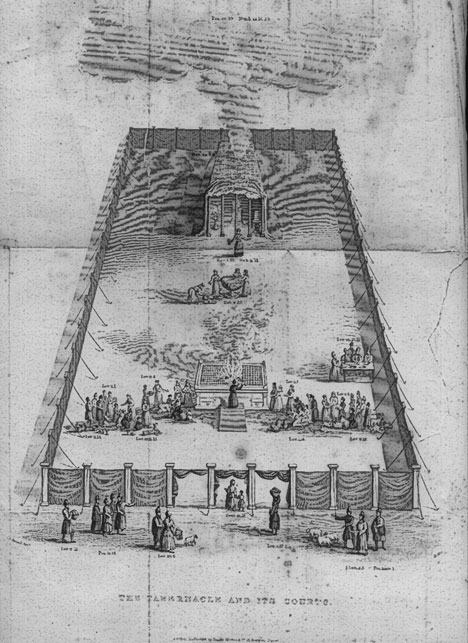Rooting Out Bitterness
Joshua Marchlewski has outlined the chiasm in Leviticus 24:13-23 (reposted here with his permission):
A. Then the Lord spoke to Moses, saying, “Bring out of the camp the one who cursed, and let all who heard him lay their hands on his head, and let all the congregation stone him
B. And speak to the people of Israel, saying, Whoever curses his God shall bear his sin. Whoever blasphemes the name of the Lord shall surely be put to death. All the congregation shall stone him.
C. The sojourner as well as the native, when he blasphemes the Name, shall be put to death.
D. “Whoever takes a human life shall surely be put to death.
E. Whoever takes an animal’s life shall make it good, life for life.
F. If anyone injures his neighbor, as he has done it shall be done to him,
F’. fracture for fracture, eye for eye, tooth for tooth; whatever injury he has given a person shall be given to him.
E’. Whoever kills an animal shall make it good,
D’. and whoever kills a person shall be put to death.
C’. You shall have the same rule for the sojourner and for the native,
B’. for I am the Lord your God.”
A’. So Moses spoke to the people of Israel, and they brought out of the camp the one who had cursed and stoned him with stones. Thus the people of Israel did as the Lord commanded Moses.
I think we can see the feasts from Leviticus 23 used as deep structure in there as well, or at least a form of the matrix with which they correspond. In this structure, we can see that the atoning death of a cursed man is a microcosm for the whole of Creation.
Creation: Lord speaks as Light (Sabbath)
Division: Sin bearer chosen to cover sin as firmament-veil (Passover)
Ascension: God’s three level house:
Sea of nations divided (sojourner and native – Gentile and Jew)
Land (Bronze Altar) rises out of it (the “dust”)
Grain and Fruit: the innocent Lamb (good animal) without blemish (Firstfruits)Testing: The ethics, the seven flaming “eyes” of the Lampstand, are applied. Notice that teeth correlate to tusks and horns [1]. The Lamb who was cursed in our place achieved the unthinkable: he was the first Man who possessed seven eyes and seven horns, the Law incarnate (Pentecost)
Maturity: The Law repeated (Deuteronomy). It is the “resurrection” altar now, the Incense. (Trumpets)
Conquest: The curser is cursed (Sanctions, Atonement)
Glorification: It is now Moses speaking, and Israel obeying, head and body, a corporate mediator of the Covenant. The outcome is rivers of blood, but the blood of one cursed man brings a spring of living water for the people. Israel is made pure again to be a blessing to the nations (Booths)
If we combine A and B, we see the same pattern as the entire process in microcosm, the Word before it takes on flesh in history:
…..Genesis – Then the Lord spoke to Moses, saying,
……….Exodus – “Bring out of the camp the one who cursed,
……………Leviticus – and let all who heard him
……………lay their hands on his head,
………………..Numbers – and let all the congregation stone him
……………Deuteronomy – And speak to the people of Israel, saying,
……………Whoever curses his God shall bear his sin.
……….Joshua – Whoever blasphemes the name of the Lord
……….shall surely be put to death.
…..Judges – All the congregation shall stone him.
The Word of the Lord is always a literary wonder.
Notice also that the hear, see, speak pattern is mimicked. Israel has heard a satan and must crush the false head before it takes on a congregational body. They must kill the root of bitterness before it grows into a tree and defiles many.
The introduction to the Lord’s judgment, ie. the crime, follows the same pattern:
Creation – Son of Israelite woman,
Division – and Egyptian father, went out…
Ascension – Egyptian hybrid son versus Israelite son (ie. seed versus seed – we see this in the Herods as well. Esau-ism makes “bitter”)
Testing – Egyptian hybrid cursed the Lord outside the camp, ie. in the wilderness
Maturity – Wisely brought the case to Moses. Tribal lineage described: Dan is the Eagle, the prophet, the legal witness
Conquest – He was put in custody (ie. behind bars, in cave, entombed, in the Most Holy)
Glorification – until the (mystery of) the mind of the Lord was opened.
If we take one more step out, perhaps we can see this pattern again. Leviticus 21 concerns the holy calling of Israelites (Creation); Leviticus 22 concerns the separation of the holy things of Israel (Division); Leviticus 23 concerns the feasts (Ascension); Leviticus 24 covers the Lampstand (Testing), the war between true and false brothers (Maturity) and the atonement for the crime (Conquest); Leviticus 25 moves into the vineyard Sabbath of Canaan. Haven’t got time to take this further, unfortunately, but the probability that there are larger ripples is good.
________________________________
[1] See Horns of Moses. It is interesting that Christ’s bones were not fractured, not scattered.



























November 13th, 2010 at 1:59 am
Fantastic. It is amazing to see the intricacy of the text laid out. This sevenfold creation pattern is great and I’m sure will be very helpful in reading. I’m listening to James Jordan’s lectures on exodus themes in scripture (available for free on wordmp3.com) and this fits that motif exactly.
Creation – the family of Jacob enters Egypt
Division – they settle in Goshen and remain separated from the Egyptians
Ascension – they are brought up, out of Egypt
Testing – wilderness wandering
Maturity – old generation dies, trusting generation goes in
Conquest – take the land under Joshua
Glorification – land at peace (especially under David and Solomon)
This is great stuff.